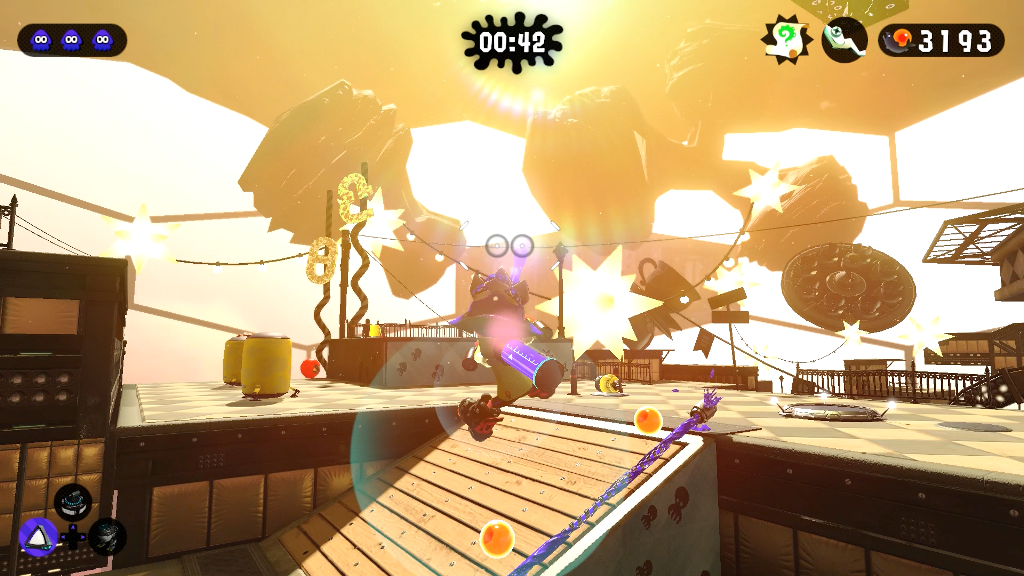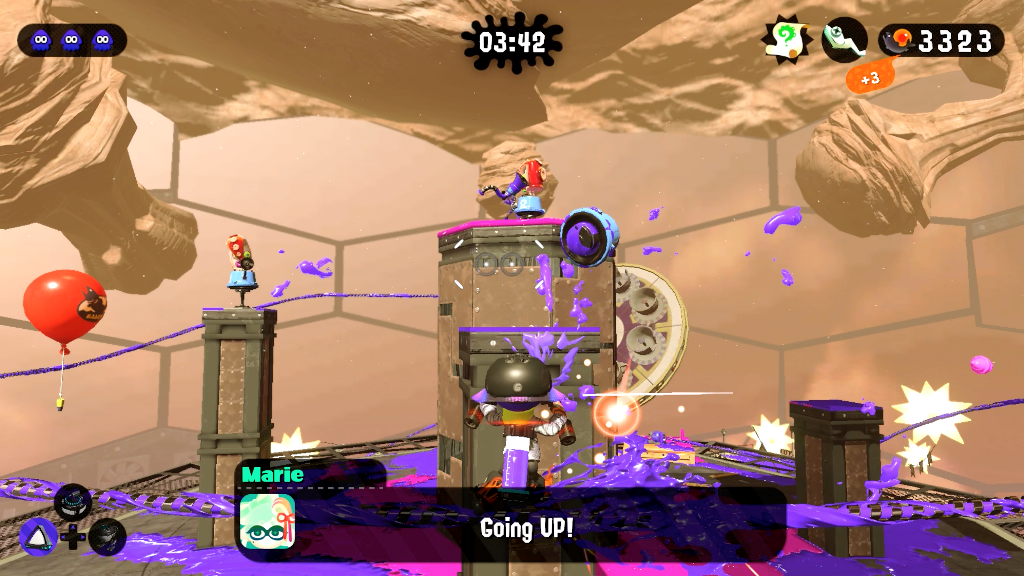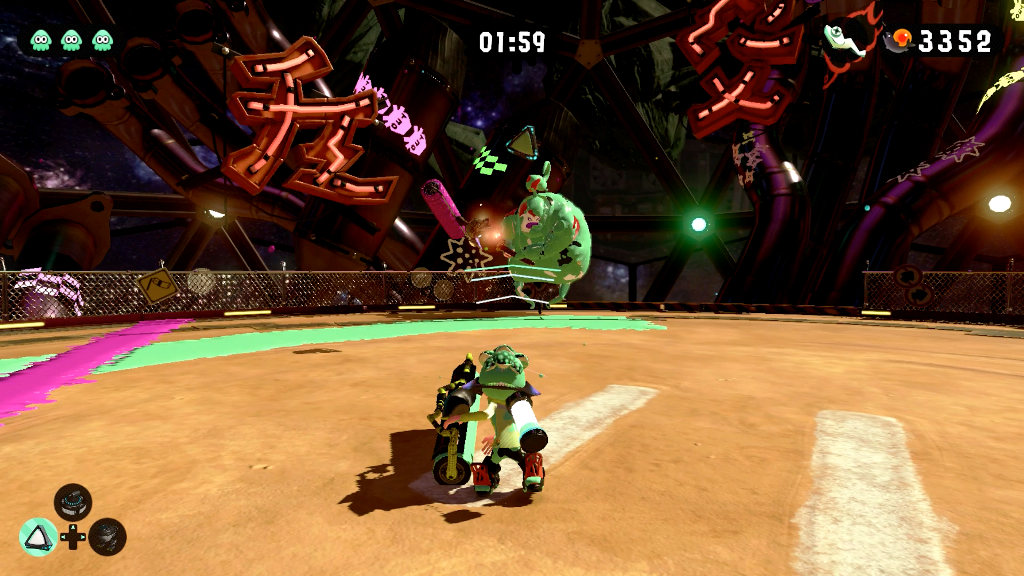Due to the online servers not yet being available this preview is entirely focused around the single player campaign. Make sure you keep an eye out for our full review where we look at the whole kit and caboodle!

If there’s one complaint people had about the original Splatoon it’s that the single player Hero Mode, whilst certainly fun, was lacking the level of depth and intricacy that had clearly been poured into the multiplayer. Given that the Splatoon series is a primarily multiplayer experience this isn’t that surprising, but nevertheless a more substantial solo experience would have pushed an already brilliant game into the seriously big leagues, and it looks like Splatoon 2 may have just about cracked it.
Initial levels are admittedly worryingly straightforward and simplistic. The level design is very basic in the early moments, and with your slow-shooting Hero Shot the pacing is supremely pedestrian. Thankfully it seems that this is designed more for absolute beginners to the series, and upon reaching the first boss (which we’re not going to spoil because it’s too damned wonderful) the difficulty takes a sudden and not insignificant turn. Upon reaching the second world all was forgiven from our perspective, as a pair of short-range but ultra-rapid fire Hero Dualies was thrust into our tentacles.

Immediately the pace picked up tremendously and we were gifted with a whole range of new and exciting level designs and elements. The utilitarian Inkrails have been replaced entirely with a new system that also allows you to grind and fire in the middle of a ride, the ink-clearing Squee-Gs that were little more than a mild pest now have giant variants that will suck the ink directly out of you before you can say ‘woomy’; everything has been turned up to eleven, and it feels fantastic.
As we explored new levels in Sectors 2 and 3 we were also gifted with other weapons to take through the levels. Every level forces you to use a pre-determined weapon the first time you play it, but if you return once it’s bested you can choose to use any weapon you like, adding an entirely new dynamic with each run.

In the original you could play through select levels with a charger, Kraken, or a roller, but not only were you restricted to what levels you could play, you’d also have to fork out for an amiibo in order to do it. Not a bit of it in this sequel; you can choose to use any of the weapons available to you in any level without having to buy anything additional, which is a massive improvement and provides a glut of replayability. You’ll also be rewarded for your efforts if you make it through a level with every weapon possible; we can’t tell you what the rewards are, but trust us when we say it’s worth the effort.
Furthermore the limited weapon upgrades from the past make a return in a more significant form. Now each weapon has the ability to be upgraded, but in order to do so you’ll not only have to grab Power Eggs by the bucketload, but also a new collectible called Sardinium. This presumably rare metal with a fishy name can be found one fish at a time in every level in the same way as the Sunken Scrolls, which also make a welcome return.

We briefly mentioned bosses, so we'd better elaborate on them a bit more. Whilst the bosses were undoubtedly fun in Splatoon (with the final boss being a particular highlight), there was a little left to be desired with them. They weren’t especially tricky and followed very linear patterns that become more of a chore than a challenge after the first few hits. In this game however they’re all infinitely more interesting. Some do follow the typical ‘dodge, dodge, hit, repeat’ formula, but each time their strategies change and, in the instance of the oft-reported Octosamurai, become surprisingly tricky.
That’s not to say everything’s perfect in the single player Hero Mode. Level design has improved stupendously but finding the stages throughout the various Sector hub worlds borders on tiresome. It does add more to a game to have to platform to get to a specific location, but when you’re looking around desperately for the last level and you’re sure you’ve been absolutely everywhere, it can become notably frustrating. Exploration is all well and good, but when you just want to progress to the Sector boss and the game hides the last hurdle from you it can be infuriating.
Overall, though, Octo Canyon has come a long way since our original ink-fuelled love affair on the Wii U; with infinitely more replayability and most of our frustrations appropriately ironed out, it deserves its place on the cart. It’s still probably not worth the full retail price by itself if you plan to never go online, but we don’t think there’s much more we could demand from it.





Comments 41
Really looking forward to the new single player content! The final boss fight in the last game was so epic.
SO EXCITED!
Really excited. I liked Splatoon's single player mode and glad they have more to offer here.
Really looking forward to Spla2n but knowing me, I won't be doing singleplayer only months after release like I did with the first one.
Wasn't finding the levels also tedious in the original Splatoon? I recall seeing people get annoyed with finding some in the first game as well.
Anyways, according to Gamexplain, the main downside the reviewer found was with the Single Player music. Saying something around the lines of it not being as notable and more low-key. Personally, I didn't find the Single Player soundtrack to be as memorable. I only remember like two or three themes from the entire thing.
I miss the days where Rare made shooters. Imagine Nintendo pulling of a single player like in Perfect Dark or Goldeneye, that would be something. Shouldn´t be that hard right? The Splatoon makers even has Perfect Dark as their inspiration
My fishbone is ready
Still waiting to see what role Callie plays.
Cool, sounds fun. I'm ready for the Splatfest!
Really looking forward to this! Can't wait until the 21st!
Can you play the multiplayer modes offline against bots? I think that would fully seal the deal for me...
more than excited!
Ink Inc. Clan is gonna bring some heat day 1
@dystome I don't think so. The only PvE is Salmon Run and that's online only. No Turf Wars against bots I'm afraid. Though Turf Wars against bots could work as sort of a Training Mode, which, to my knowledge, isn't in the game.
I think the criticism of the Amiibo is a bit off... it implies that they were needed to unlock the full single-player mode, which is mis-leading.
The single-player mode was restricted to only the splattershot, and could be fully completed without any amiibo.
The Amiibo provided additional challenges that allowed you to revisit select levels with different weapons in order to unlock special gear... basically just acting as paid DLC.
And saying that this is not the case in Splatoon 2 also seems to be questionable, seeing as they've already revealed Amiibo exclusive gear, so there is a good chance they'll once again offer additional challenges in order to unlock that gear.
@GoldenGamer88 Local Salmon Run is a thing.
Nintendo seems to love to give their villains big lips.
So, Alex, how about length? "It’s still probably not worth the full retail price by itself if you plan to never go online" makes me worried that the biggest problem with the campaign hasn't been addressed. I loved it and I'm glad it's been improved. I just hoped it lasted longer. And no, replayability isn't enough.
@Indielink Don't you need multiple Switchs for anything local in Spla2n? Or does it work with, i.e. two Pro Controllers on one Switch and one copy? If so, Salmon Run would start to interest me. Right now, I'm just meh about it.
@GoldenGamer88 I keep asking/searching for an answer to this as well, and everything points to not having local 4 or 2 player split-screen. Only part of game that will suck in my opinion. It 1000% should be an option, even if frame rate drops.
Whoa, whoa, whoa... Finding levels in the hub world is one of the best parts of the single player. The harder to find, the better.
I've been wanting a simple race-style mode for quick, easy splitscreen. Each player has a narrow track to ink and swim with powerups to help ink, speed up, or protect themselves and weapons to disrupt and ink the other player's track. It would be a relatively easy inclusion that would focus on training movement while offering a bonus splitscreen mode.
EDIT: Otherwise it just doesn't seem feasible to shoehorn splitscreen into the modes already available considering the performance and visibility compromises. So any splitscreen likely relies on conjuring an equivalent mode.
That said, my belief is they should simply expand the test area into something more varied. Like having time trial type race tracks to test mobility gear and a shooting range a ridable tower and with moving targets.
Maybe even an assortment of bomb modes: curling bomb bowling, splat bomb basketball, and, uhh, suction bomb monkey target. So take all this and then simply allow these areas to be played in rounds for a high score mode perfect for couch multi.
This type of content would be ready-made for splitscreen play given the low intensity and narrowed focus. Anyway, I think this sort of approach would offer a lot of options and incentive for easy testing+ training.
@JarJarBlacks Yeah, I haven't found anything to verify my question either. I doubt it'll be the case. Though a bit sad, it's not a big loss to me personally since I haven't actively been longing for couch coop with Splatoon. Online Turf War is enough for me.
I've hope's, albeit not high.
I'm so pumped for this game. It would be well worth the price for me even without any single player content.
Can't wait, I really like the solo missions in Splatoon
Sounds good. I was already pretty happy with the single-player mode in Splatoon, and it sounds like this one-ups it with better bosses and more replayability.
Sounds promising. Also would love a full length campaign of Splatoon someday.
Thrilled to hear there's incentive to replay levels with alternate weapons.
Sound very promising and I'm looking forward to playing ita great deal. I really enjoyed the single player in Splatoon 1 despite its' short length and despite the fact, that some of the design felt indeed rather basic. There was still something to the look and feel of the game, the movement and just the colorful creativity of it all, that made it quite enjoyable.
Anyways, I was a bit disappointed with the fact that the online co-op will bring back that silly 'timed event' thing, and I'm generally worried, that the online integration I'm looking for (it's not just about voice chat), might still not be there on the Switch - despite the dedicated app or maybe even because of that.
All I really wanted was a system like on the PS4 (and basically on X1 and Steam as well), where you can see at first glance what your buddies are doing, being able easily join them, or have them join you, hang out with them in chatrooms (either participating, using text or voice, or just listening^^), while also being able to easily add (and if necessary remove) strangers ... and all of that in a convenient all-in-one-place solution, with gamemodes back the whole system in terms of a flexible and fast matchmaking filling up half-empty groups, machting groups of similar skill-levels and so on and so forth.
I've spend most of my time plaiyng Splatoon alone (part of the issue was that few people I knew actually had a WiiU or rarely used it), but part of it was also that there was no way to do easily communicate with them on the system, and get a party going.
It sounds mundane, but these things ought to be really easy and straight forward, so everyone can use them at will, and there should be no artifical hurdles involved, like a whole nother device like a smartphone or PC/Latop for example.
It's not so much a matter of whether it's a working solution or not, but whether it is a convenient one, that people will actually make us of.
Who knows though, maybe the app will be great, and it will all work out for the best - despite my scepticism.
@Kalmaro As much as I loved playing online, that final boss is probably my single favorite thing about the original Splatoon. So incredible.
@ricklongo Yeah that was one of the most fun bossfights of the last few years. Quite difficult to defeat with the roller.
@ricklongo That fight was hype. How often does a game have two pop divas cheering you own as you fight a big baddie by signing an actually catchy version of your own national anthem? Leave it to Nintendo...
Can't wait to play this! looks fantastic.
after watching the first 30 seconds of the video all I could think of was wanting more Kid Icarus
This game looks really good, I can't wait for the 21st!
Awesome! I really did enjoy the first game's single player, so hearing that the sequel has an improved version just keeps pumping my hype for the game!
nice review, the game looks really enjoyable can't wait
" It’s still probably not worth the full retail price by itself if you plan to never go online, but we don’t think there’s much more we could demand from it."
This is all I need to know. Thanks for saving me money, i'll be on the lookout for a sale or just skip. I do not want to support paid online whenever it comes, and the first Splatoon already bored me before I even got to the final boss (luckily, that boss was great, too bad everything else felt very spartan).
I dont get good internet speed. Not often I get a chance for multipler games. Seems like the single player is not worth a full price purchase. I wait until it hit the bargin bin.
So is it worth it if we only want to play single player?
**edit**
" It’s still probably not worth the full retail price by itself if you plan to never go online, but we don’t think there’s much more we could demand from it."
... ugh. Never mind.
As none of my IRL friends have a Switch, I might dip now and then into multiplayer online but really I'd be getting this for the solo campaign. Don't think this is a day one purchase for me; I'll be holding off for a sale unless How Long To Beat comes back with some good news. Kind of the same deal as with ARMS - although at least that has splitscreen. Thank goodness we also have Mario and XC2 coming.
Show Comments
Leave A Comment
Hold on there, you need to login to post a comment...